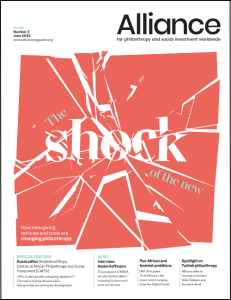Much has been written about the debate between trust-based philanthropy and those who are seeking greater evidence to guide their giving. The irony of this debate is that it is taking place in a macro context in which colossal sums of philanthropic capital are amassed in opaque structures such as donor-advised funds that provide a tax incentive to donors without necessarily, and certainly not immediately, unleashing this capital for ‘phil-anthropy’, the love of humanity. On the other end of the spectrum, some non-profits receive large amounts of funding from wealthy philanthropists because they are big, more visible – and often excel in marketing and image curation.
Greed and ego feed a philanthropic system that largely serves itself.
The list of paradoxes that reinforce systemic inequality in philanthropy, and in fact, in the world at large, is indeed long: the philanthropic system benefits those who give rather than reward the work of non-profit leaders, or social entrepreneurs, left out of a system that punishes them for being innovative, small, working in jurisdictions that are remote from ‘the West’ and/or do not have marketing budgets to build visibility.
This is why the philanthropic system is, in my view, in need of a serious rethink around governance and a re-centring toward the forgotten stakeholder.
Who are the key stakeholders of this system?
The first stakeholder is the government or the state that regulates the third sector and needs some accountability on the philanthropic flows of capital. As evidenced in many cases in the last decade, from India to Russia, the state can also use its regulatory power to block or control the activities of non-profits, for instance, for political or geopolitical motives. That is a challenge in itself.
The second stakeholder is the donor or funder of non-profits, including the various banking or intermediary structures that enable giving. The contradictions of that ecosystem are many, as pointed out, but it is perhaps important to recall that while much is written about large – and largely theoretical – pledges or giving by an increasing number of billionaires globally, giving is still steadily done by the middle class, those who are keen to give more after they have experienced some success and luck, and large crowds moved by humanitarian or specific causes close to their hearts.
The third stakeholder is the recipient of philanthropic giving, the non-profit, or equivalent structure. Issues around mutual trust and accountability between funders and fundees, including the state, are regularly revisited based on scandals in the operations of non-profits, the provenance of funding or strings attached with particular donations – an example of which is vividly presented in the poignant film All the Beauty and the Bloodshed.
The fourth, or what I call the forgotten stakeholder, is the end-user, or what some call the beneficiary (a power-laden term I prefer to stay away from). In short, the end-user is the ultimate client, person, community, species one is ultimately working for. The end-user’s point of view is often still forgotten in the design of interventions, and imperfectly captured in quantitative and qualitative terms. This is what is often labelled as ‘impact’, and has grown, in the last decade or so, into its own ecosystem of advisors and intermediaries, over-spilling the philanthropic world, into the private sector, as the entire world aims to align prosperity, people, and planet.
Each of these four stakeholders operates in disconnected ways giving us a skewed or partial way of approaching the overall performance of philanthropy – and doing good, more broadly.
This is precisely why a small group of thinkers and doers at Insaan Group designed Impact Footprint, a digital tool to showcase innovative, impactful solutions to the United Nations Sustainable Development Goals (SDGs). Impact Footprint provides a standardised, comparable, and yet succinct and accessible way to discover and understand the performance of non-profits and social enterprises with a focus on impact, finance, and governance. It demystifies impact to re-centre doing good around meaningful metrics.
Impact Footprint was just launched at the spectacular and thought-provoking Ibrahim Governance Weekend (IGW) in Nairobi. Whilst plans are to embed AI and machine learning to better connect existing information on non-profits, funder preferences, and embed the voices of end-users through video and ratings by the end-users themselves, the initial feedback received by a non-profit is already promising: ‘I really like this tool because it is about governance. Just filling it helped us think more deeply on our impact, our cost-effectiveness, and created more alignment between how our Board thinks and how our field teams operate.’
Reconciling the four stakeholders and most importantly encouraging a conversation on how the ‘doing good’ system, within and beyond philanthropy, can move closer to the field, closer to innovation, closer to the real metrics of human change is imperative to tweak our current disconnected and top-down philanthropic architecture. Re-centring the forgotten stakeholder, the voice of the end-user, building on rapid advances in technology, is urgent to re-ignite the essence of philanthropy, the love of humankind, and unlock greater flows of capital to build a more equitable and sustainable world.
Farahnaz Karim is a mother, political scientist, impact entrepreneur, and academic. She is the founder of Insaan Group which invests in solutions to poverty in sub-Saharan Africa and India.
Upcoming issue: New giving vehicles and tools
 New giving vehicles and tools have proliferated in recent years with the conventional foundation model supplemented by donor advised funds, limited liability companies and personalised giving services. At the same time, technology is providing more direct means of fundraising and bringing in new people as donors. What are the implications of these changes? Is the conventional foundation model at risk of being supplanted? And are new means of individual giving producing greater democracy? This special feature explores the implications for institutional philanthropy.
New giving vehicles and tools have proliferated in recent years with the conventional foundation model supplemented by donor advised funds, limited liability companies and personalised giving services. At the same time, technology is providing more direct means of fundraising and bringing in new people as donors. What are the implications of these changes? Is the conventional foundation model at risk of being supplanted? And are new means of individual giving producing greater democracy? This special feature explores the implications for institutional philanthropy.
Subscribe today so you don’t miss it! Or you can pre-order the single issue here with a 20% discount.






Comments (0)